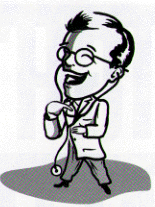
Fam Pract Manag. 1998;5(8):72-75

While performing a flight physical on an airline pilot, I noticed his blood pressure was 8 mm Hg over the acceptable limit for certification. The patient had no history of blood pressure problems, so I asked the nurse to recheck his pressure after a few minutes. Still, his reading was unacceptably elevated. I asked my nurse to wait a few more minutes and recheck his pressure again — but this time I handed the patient a copy of a humor digest and asked him to read it while he waited. After 10 minutes, his blood pressure had dropped 12 points, well within the safe range, and our doctor-patient bond was suddenly stronger.
This story illustrates the power of humor. It can change our attitudes, our relationships, even our health. But as physicians we often neglect to employ humor in our personal and professional lives and thereby deprive ourselves and our patients of a wonderful tool.
We all know that humor and laughter are good for us. Norman Cousins analogized laughter as “jogging for the intestines” because of its effects on our pulse and respiration rates, and the surging endorphins released by laughter create a pleasurable sensation and have an analgesic effect. These chemical changes also can enhance the immune response. If a pharmaceutical company were to introduce a new product with the same benefits and cost-efficiency as humor and with a similar side-effect profile, we would readily embrace it in our practices.
Healing power aside, humor has other benefits as well. It makes each of us more alert, helps us retain information and maximizes our receptivity to new ideas. It can also reduce psychological tension between patients and doctors. According to humor expert and author Dale Anderson, MD, physicians who employ humor are generally perceived in a more positive light by patients. Patients view them as being more outgoing, friendly, approachable and trustworthy.
Humor and laughter may even be effective tools for risk management. Researchers studying malpractice claims found that primary care physicians with no claims filed against them laughed and used humor more often during office visits than those physicians with higher claims profiles.1
To some, having a sense of humor means the penchant for telling a good joke (or sometimes a not-so-good joke). I don't believe it has anything to do with one's joke-telling ability but is more a way of experiencing life to its fullness, human foibles and all.
For me, the richest sources of humor are the everyday incidents that occur in the office involving my staff, patients or, most commonly, me. One of my hall-of-fame moments was when I gave a female patient a sample box of what I thought were estrogen patches. Imagine my chagrin when she returned later to show me that the box was a promotional item that contained not patches but Post-it notes!
The idea of laughing at our mistakes and injecting humor into the clinical encounter may seem inappropriate to some. After all, ours is a serious business. But while we should take medicine seriously, we need not take ourselves so seriously. To develop a humor-centered approach to life, start looking for those humorous moments in your day. Keep a humor log or journal of your most embarrassing or amusing memories. Tack up a cartoon on the office bulletin board. Share a (tasteful) joke. Or develop your own humor library. Mine consists of clippings from newspapers and various humor publications. And of course the Internet is a motherlode of humorous material. (See “Where to go for laughs.”)
In our chaotic health care environment, we need to take advantage of every opportunity to bring patients and physicians together as partners in the healing process and to maximize the use of therapeutic adjuncts that are effective and cost-efficient. Humor fulfills these criteria.
Of course, humor is not a cure-all for serious medical problems. As Anderson says, “There are serious medical problems that cannot and should not be laughed off. Anyone who believes we can substitute laughter for quality medical care may literally die laughing.” But if we use humor sparingly and appropriately, as a chef uses spices and seasonings, we can enhance our own health and well-being as well as that of our patients and our communities.
Where to go for laughs
Books
Head First: A Biology of Hope. N. Cousins. New York: E.P. Dutton; 1989.
The Healing Power of Humor: Techniques for Getting Through Loss, Setbacks, Upsets, Disappointments, Difficulties, Trials, Tribulations and All That Not-so-Funny Stuff. A. Klein. Los Angeles: J.P. Tarcher; 1989.
Healthy Pleasures. R. Ornstein, D. Sobel. Reading, Mass: Addison-Wesley; 1989.
The Laughter Prescription: The Tools of Humor and How to Use Them. L. Peter, B. Dana. New York: Ballantine Books; 1982.
Learned Optimism. M. Seligman. New York: A.A. Knopf; 1991.
Organizations
The HUMOR Project Inc. publishes a HUMOResources catalog, which can point you to books and other publications related to humor and work. The organization also publishes a quarterly magazine, Laughing Matters. 800-225-0330; http://www.humorproject.com
The Humor Potential offers lectures and products on stress reduction and humor and publishes a quarterly newsletter, the TADAH Gazette. 800-99-TADAH; http://www.stressed.com
The American Association for Therapeutic Humor explores humor and laughter as they relate to healing and well-being. 314-863-6232; http://www.aath.org
Pure laughs
Funny Times, a monthly collection of humor and cartoons. 216-371-8600; http://www.funnytimes.com